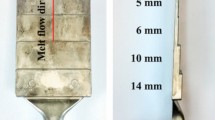Abstract
The finite element model of a die manufactured by the bimetal-gradient-layer surfacing method was established based on ZG29MnMoNi casting steel. Then, simulation was conducted to analyze the temperature field of the die and its cycle features under working conditions. By comparing the microstructure and properties of cast-steel matrix of the die before and after producing 5761 parts on a 63MN hot die forging press, sensitive indexes that affect the service life of the surfacing die were determined. The results have shown that the microstructure of cast-steel matrix before and after service is both pearlites and ferrites. When it is closer to the welding line, the carbides precipitate out more obviously, the dendrites segregate less, and the microstructure tends to be more compact. The mechanical properties are decreased as a whole after service: the tensile strength, yield strength, reduction of area, and elongation are declined by 7, 17, 24, and 18 %, respectively. Meanwhile, microhardness and impact toughness have shown a decrease of 10 and 28.6 %, respectively. The working temperature has a strong relationship with microstructure and property changes. The performance of cast-steel matrix after service can still satisfy the operating requirements of the 63MN hot die forging press, which can be recycled in remanufacturing process.
Similar content being viewed by others
References
He JJ, Lan J, Zhai CQ (2000) Precision casting processes of die casting dies[J]. Foundry 49(3):156–159
Zhou J, Lu S, Quan GZ. A method of dual metal layer manufacturing mold based on casting-steel substrate: China,ZL200910104604. X[P]. 2011-01-12
Trethewey KR, Roberget DR (1995) Corrosion management in the twenty-first century[J]. Br Corros J 3:192–197
Shah S, Narendra B (2002) Laser surface-engineered vanadium carbide coating for extended die life[J]. J Mater Process Technol 124(2):105–112
Cheng PY, Zhan W (1999) Die life and materials[M]. Machinery Industry Press, Beijing, pp 89–90
Falk B, Engle U (1998) Estimation of tool life in bulk metal forming based on different failure concepts[J]. J Mater Process Technol 81:602–607
Li FG, Cai J, Geng J (2007) Analysis of thermal load for die cavity surface[J]. China Met Form Equip Manuf Technol 1:48–51
Albertin E, Sinatora A (2001) Effect of earbider faction and matrix microstructure On the Wear of eastiron balls tested in a laboratory ball mill [J]. Wear 2(50):492–501
Liu DX, Li XD, Ren HH (2006) Use of the hot exchange method on analyzing temperature field of the hot forging die[J]. Die Mould Technol 1:16–18
Lu X, Zhou J, Zhang JS (2015) Optimization of welding thickness on casting-steel surface for production of forging die[J]. Int J Adv Manuf Technol 76:1411–1419
Wu YZ (2010) Thermo-mechanical load in the near-surface layer of hot die forging die impression[D]. Wuhan University of Technology
Cui ZX, Jia YC (2007) Metallography and heat treatment[M]. Machinery Industry Press, Beijing, p 50
Zhang HJ, Dai JW, Zhu Y (1996) Investigation on low temperature temper embrittlement of 20Cr2NiA steel[J]. Phys Test Chem Anal A Phys Test 32(6):11–14
Chen W, Gao YM, Xing JD (2008) Composition design of low alloy cryogenic cast steel with analysis of microstructure and mechanical properties[J]. J Xi’an Jiao Tong Univ 42(7):876–877
Wang HC, Xiao H, Cheng L (2010) Simulation analysis and influencing factors research of hot forging die’s temperature gradient near surface layer[J]. Hot Work Technol 39(289):34–37
Zhang ZS (2008) Temperature field and stress field simulation and analysis of different materials hot die forging[D]. Wuhan University of Technology
Fratini L, Pasta S (2012) Residual stresses in friction stir welded parts of complex geometry[J]. Int J Adv Manuf Technol 59(5):547–557
Author information
Authors and Affiliations
Corresponding author
Rights and permissions
About this article
Cite this article
Zhang, J., Zhou, J., Tao, Y. et al. The microstructure and properties change of dies manufactured by bimetal-gradient-layer surfacing technology. Int J Adv Manuf Technol 80, 1807–1814 (2015). https://doi.org/10.1007/s00170-015-7170-7
Received:
Accepted:
Published:
Issue Date:
DOI: https://doi.org/10.1007/s00170-015-7170-7




